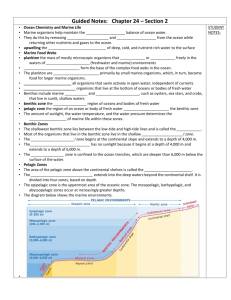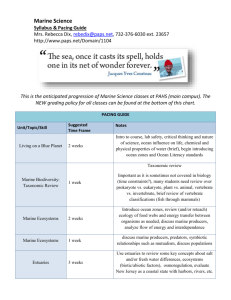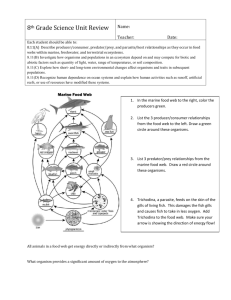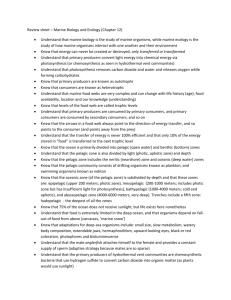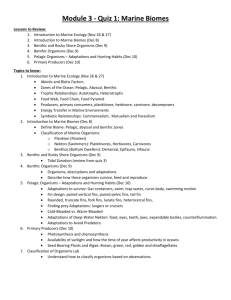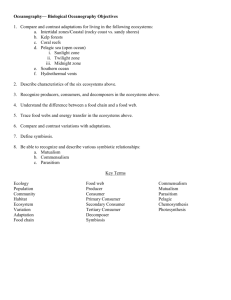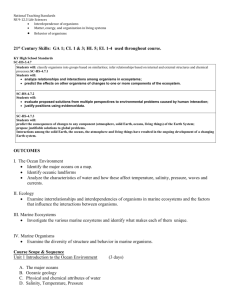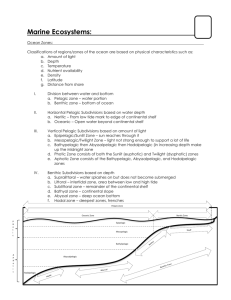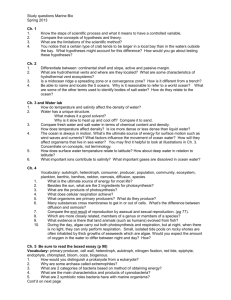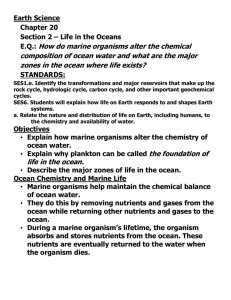GS 108 Oceanography Lecture Exam 3 Study Objectives
advertisement
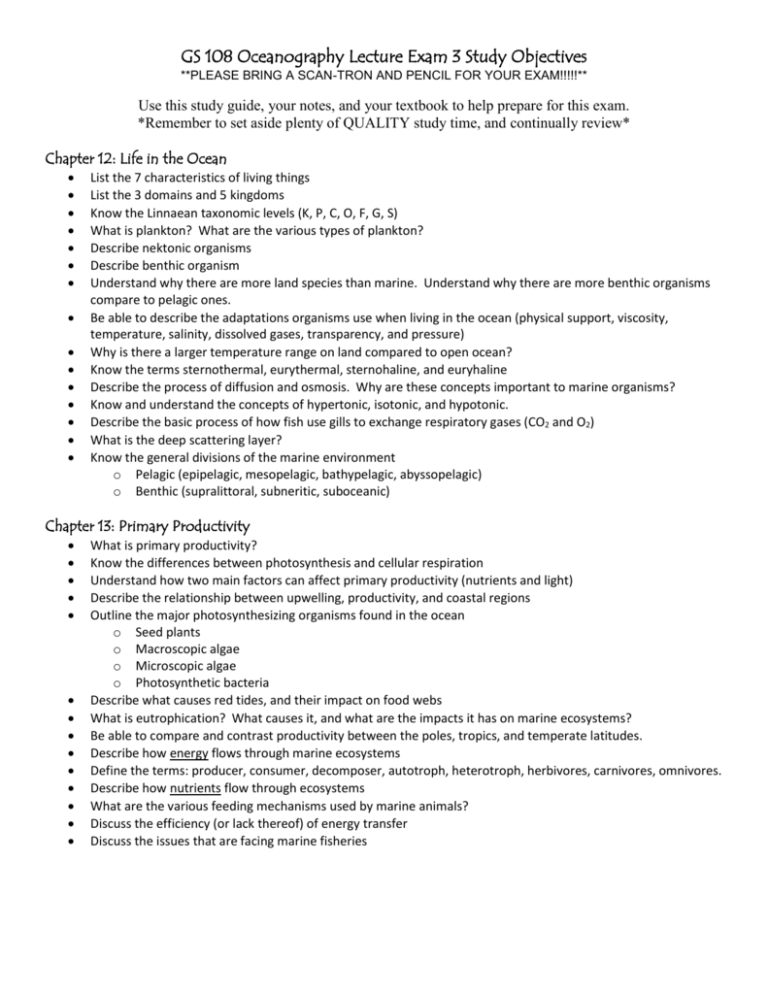
GS 108 Oceanography Lecture Exam 3 Study Objectives **PLEASE BRING A SCAN-TRON AND PENCIL FOR YOUR EXAM!!!!!** Use this study guide, your notes, and your textbook to help prepare for this exam. *Remember to set aside plenty of QUALITY study time, and continually review* Chapter 12: Life in the Ocean List the 7 characteristics of living things List the 3 domains and 5 kingdoms Know the Linnaean taxonomic levels (K, P, C, O, F, G, S) What is plankton? What are the various types of plankton? Describe nektonic organisms Describe benthic organism Understand why there are more land species than marine. Understand why there are more benthic organisms compare to pelagic ones. Be able to describe the adaptations organisms use when living in the ocean (physical support, viscosity, temperature, salinity, dissolved gases, transparency, and pressure) Why is there a larger temperature range on land compared to open ocean? Know the terms sternothermal, eurythermal, sternohaline, and euryhaline Describe the process of diffusion and osmosis. Why are these concepts important to marine organisms? Know and understand the concepts of hypertonic, isotonic, and hypotonic. Describe the basic process of how fish use gills to exchange respiratory gases (CO2 and O2) What is the deep scattering layer? Know the general divisions of the marine environment o Pelagic (epipelagic, mesopelagic, bathypelagic, abyssopelagic) o Benthic (supralittoral, subneritic, suboceanic) Chapter 13: Primary Productivity What is primary productivity? Know the differences between photosynthesis and cellular respiration Understand how two main factors can affect primary productivity (nutrients and light) Describe the relationship between upwelling, productivity, and coastal regions Outline the major photosynthesizing organisms found in the ocean o Seed plants o Macroscopic algae o Microscopic algae o Photosynthetic bacteria Describe what causes red tides, and their impact on food webs What is eutrophication? What causes it, and what are the impacts it has on marine ecosystems? Be able to compare and contrast productivity between the poles, tropics, and temperate latitudes. Describe how energy flows through marine ecosystems Define the terms: producer, consumer, decomposer, autotroph, heterotroph, herbivores, carnivores, omnivores. Describe how nutrients flow through ecosystems What are the various feeding mechanisms used by marine animals? Discuss the efficiency (or lack thereof) of energy transfer Discuss the issues that are facing marine fisheries Chapter 14: Animals of the Pelagic Environment Describe the various adaptations pelagic animals have for their environment o Staying afloat o Swimming o Seeking prey o Avoiding predators Mobility Speed Thermoregulation Bioluminescence Schooling Symbiosis (commensalism, mutualism, parasitism) Others (speed, poison, mimicry, transparency, camouflage, countershading) What are the characteristics that define a mammal? Be able to give an example for each of the three orders of marine mammals o o o Carnivore Sirenia Cetacean Chapter 15: Animals of the Benthic Environment Describe the reason for zonation in rocky shore ecosystems What are some organisms and their adaptations that are found in the: o o o o Describe the physical environment of the sandy shore? What are some of the organisms and their adaptations that are found on/in sandy beaches? What are some organisms and their adaptations of rocky bottom (subtidal) ecosystems? o Kelps, lobsters, oysters Describe what corals are (polyps, symbionts, carbon skeletons) Where are corals normally found in the world’s oceans? Describe the importance of corals and coral reefs. Describe the factors that are affecting the health of coral reefs o o o Supratidal zone (spray) High tide zone Middle tide zone Low tide zone Bleaching Diseases Human activity Discuss the physical characteristics of the deep ocean Where do animals that live in the deep ocean get their food? How is chemosynthesis different from photosynthesis? Similar? Chapter 11: The Coastal Ocean Describe the two types of coastal wetlands (salt marshes and mangrove swamps) Why are coastal wetlands so valuable? What threats are they facing? Discuss the impacts of the various types of pollution in the ocean o o o o o Petroleum Sewage sludge DDT and PCB’s Mercury Non-point pollution and trash Describe how mercury and other organic toxins accumulate in food webs (bioaccumulation/biomagnification) Discuss the impacts of non-native species

